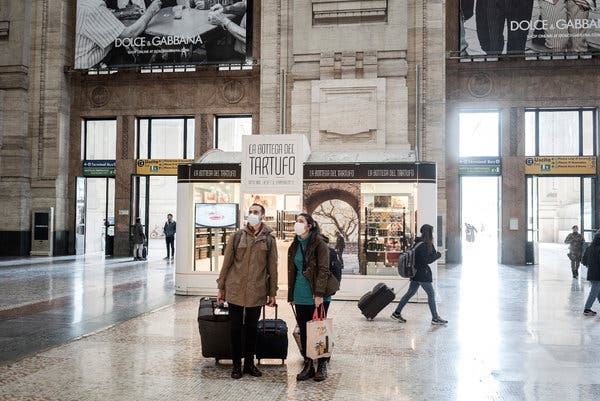Good morning.
We’re covering a coronavirus lockdown in northern Italy, life in Syria’s last rebel stronghold and a big day in Afghanistan.

Italy imposed an unprecedented peacetime lockdown on Sunday that will affect 16 million people across much of the country’s north, as officials reported a more than 50 percent surge in confirmed cases from a day earlier. Here are the latest updates on the virus and a map of where it has spread.
Italy now has 7,375 confirmed cases, and 366 people have died from Covid-19, the disease caused by the virus. The government’s move is a sign that restrictive clampdowns — which clash with core values of Western democracies — might be necessary to contain and defeat the epidemic.
“We are the new Wuhan,” one Milan resident told our reporter, referring to the Chinese city where the virus was first discovered, and which was later cordoned off by the authorities.
But debate has already erupted over how well the Italian government will be able to enforce the new rules — and whether Italians will obey them.
Yesterday: As the toll from the virus in the United States topped 500 cases on Sunday, American officials worried that existing containment efforts weren’t enough. The country’s leading expert on infectious diseases said that officials must “be prepared to take whatever action is appropriate to contain and mitigate the outbreak.”
Markets: Asian markets opened sharply lower today, after Saudi Arabia slashed its export oil prices over the weekend and as investors digested the relentless global spread of the coronavirus. Investors predicted sharp drops in Wall Street and Europe as well.
Cruise ship: The Grand Princess, which has been held off the coast of California after 21 people onboard tested positive for the virus, was expected to dock in Oakland today. Passengers will then be taken to military facilities around the United States to be tested and quarantined.
As officials across Europe scramble to slow the outbreak of the coronavirus, this much is clear: Public health measures that make sense for one country can have negative effects on its neighbors.
The Italian lockdown may ultimately save lives, for example, but analysts say it will paralyze the country’s economic heartland and almost certainly tip the continent into recession.
Officials in Brussels have also criticized efforts by France, Germany and the Czech Republic to lift controls on the export of protective medical gear — moves that test a sense of unity that was frayed by Britain’s recent departure from the bloc.
Go deeper: Europe’s generous social policies — including programs and regulations that protect workers, provide low-cost health care or help companies get through lean periods — could serve as a vaccine against a recession.
On a recent trip from Turkey into Idlib Province in northern Syria, our journalists met frightened residents who were camping in bombed-out buildings and scanning the skies for jets. Others had decamped to settlements along the Turkish border, where blue and white tents pockmark rocky hillsides and olive groves.
Some of Idlib’s civilians still cling to the hope that Turkey’s growing deployment of troops into the province will stop an onslaught against rebels by Syrian government forces and Russian warplanes. But even though a cease-fire that took effect last week appears to be holding, few believe it will last.
Related: Five years ago, many people on the border island of Lesbos, Greece, greeted Syrian refugees with empathy as they traversed the country en route to northern Europe. Now some Lesbos residents are forming civilian patrols to round them up — and setting up roadblocks to stop them from reaching refugee camps.
If you have 8 minutes, this is worth it
Lisa Nandy, above, who is vying to lead the opposition Labour Party in Britain, has more centrist politics than her main rivals. That’s one of the reasons she is a clear underdog in a race that Keir Starmer, the party’s Brexit policy leader under Jeremy Corbyn, is favored to win.
But Ms. Nandy, 40, is a woman from the north of England — the place where analysts say Labour betrayed its working-class roots. In that sense, she represents an alternative model for how the party might rehabilitate itself from the losses it suffered under Mr. Corbyn’s leadership.
“This has been a really long time coming,” she said of the recent election failure, “and I don’t think the Labour Party has had an honest reckoning with how deep this is and how long and how far back the roots of this go in communities like mine.”
Here’s what else is happening
Lebanon: Amid calls by protesters for the government to prioritize domestic concerns, the country plans to default on $1.2 billion in foreign currency debts that are coming due today.
Afghanistan: President Ashraf Ghani was expected to be sworn in for another term today, but his rival in a disputed September election has issued invitations to a parallel swearing-in ceremony. The dueling events may threaten peace talks over the country’s future between the United States and the Taliban that are scheduled to start tomorrow.
Political spies: Erik Prince, a security contractor close to the Trump administration, worked to recruit former American and British spies to infiltrate groups considered hostile to the Trump agenda, a Times investigation found.
Nazi collaborators: A U.S. judge last week ordered a 94-year-old man to return to Germany, where he remains a citizen and where he served as a guard in a Nazi concentration camp during World War II. It may be the end of a long-running effort to root out Nazi collaborators from often cozy American existences.
António Guterres: In an interview for The Times’s “In Her Words” newsletter, the United Nations secretary general explained why he calls himself a feminist.
Snapshot: Above, demonstrators clashed with the police in Santiago, Chile, during an International Women’s Day march on Sunday. People across Latin America, from Buenos Aires to Mexico City, protested against inequality, femicide and strict abortion controls.
Sports profile: Our reporter traveled to the Czech Republic to interview Adam Ondra, the world’s best climber.
What we’re reading: This architectural deconstruction in The Texas Observer. “Boxy minimalist homes reflect more than aesthetics,” writes the Briefings editor, Andrea Kannapell. “I didn’t realize how much more until I read this.”
Now, a break from the news
Cook: French onion soup. It comes from a 1954 pamphlet The Times simply called “Soups,” which had 20 recipes for soups “thick and thin, hot and cold,” but our cooking team has updated this one recipe with sherry and wine to layer in more flavors.
Watch: “Hillary,” a four-part documentary about Hillary Clinton, examines the public fixation on the former first lady and presidential candidate.
Read: “Capital and Ideology,” the latest book by the French economist Thomas Piketty, outlines a grand theory of inequality.
Smarter Living: Data overages from your wireless carrier can add up quickly. Here’s how to keep your bill under control.
And now for the Back Story on …
The coronavirus outbreak can be tough to follow, especially the statistics. Adam Kucharski, who studies the math behind outbreaks for the London School of Hygiene & Tropical Medicine, recently talked to The Times about how people should look at the data.
One signal Mr. Kucharski looks for is when the first case in an area is a death: “That suggests you had a lot of community transmission already,” he said.
“Suppose the fatality rate for cases is about 1 percent, which is plausible,” he continued. “If you’ve got a death, then that person probably became ill about three weeks ago. That means you probably had about 100 cases three weeks ago, in reality.”
“In that subsequent three weeks,” he added, “that number could well have doubled, then doubled, then doubled again. So you’re currently looking at 500 cases, maybe 1,000 cases.”
When considering the fatality rate, Mr. Kucharski suggested people pay attention to the variable risk level for different age groups, particularly people in their 70s and 80s.
“Over all we’re seeing maybe 1 percent of symptomatic cases are fatal across all ages,” he said. “What’s also important is that 1 percent isn’t evenly distributed. In younger groups, we’re talking perhaps 0.1 percent, which means that when you get into the older groups, you’re potentially talking about 5 percent, 10 percent of cases being fatal.”
That’s it for this briefing. See you next time.
— Mike
Thank you
To Mark Josephson and Eleanor Stanford for the break from the news. You can reach the team at briefing@nytimes.com.
P.S.
• We’re listening to “The Daily.” Our latest episode is about the agreement between the U.S. and the Taliban.
• Here’s today’s Mini Crossword puzzle, and a clue: Underneath (five letters). You can find all our puzzles here.
• Parul Sehgal, a Times book critic, talked about her middle-of-the-night reading schedule, her review process and more for The Cut’s “How I Get It Done” feature.





